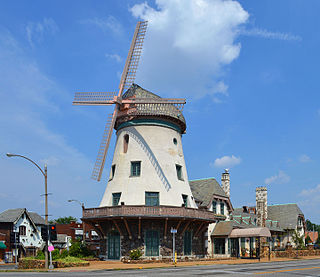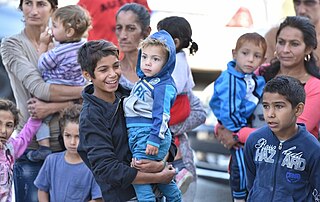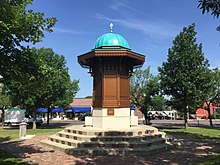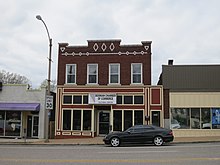
St. Louis is an independent city in the U.S. state of Missouri. It is located near the confluence of the Mississippi and the Missouri rivers. In 2020, the city proper had a population of 301,578, while its bi-state metropolitan area, which extends into Illinois, had an estimated population of over 2.8 million. It is the largest metropolitan area in Missouri and the second largest in Illinois. The city's combined statistical area (CSA) is the 20th largest in the United States.

Srebrenica is a town and municipality in Republika Srpska, Bosnia and Herzegovina. It is a small mountain town, with its main industry being salt mining and a nearby spa.

Canton 10, is one of the ten cantons of the Federation of Bosnia and Herzegovina, a political entity of Bosnia and Herzegovina. It is the largest canton by area and eighth by population. The local government seat is in Livno, while the assembly is in Tomislavgrad. It is divided into five municipalities: Bosansko Grahovo, Drvar, Glamoč, Kupres, Tomislavgrad and one city, Livno.

Jajce is a town and municipality in the Central Bosnia Canton of the Federation of Bosnia and Herzegovina, an entity of Bosnia and Herzegovina. According to the 2013 census, the town has a population of 7,172 inhabitants, with 27,258 inhabitants in the municipality, It is situated in the region of Bosanska Krajina, on the crossroads between Banja Luka, Mrkonjić Grad and Donji Vakuf, on the confluence of the rivers Pliva and Vrbas.

Islam is the most widespread religion in Bosnia and Herzegovina. It was introduced to the local population in the 15th and 16th centuries as a result of the Ottoman conquest of Bosnia and Herzegovina.

Šamac, formerly Bosanski Šamac is a town and municipality in Republika Srpska, Bosnia and Herzegovina. There are also small, uninhabited, parts located in the municipalities of Odžak and Domaljevac-Šamac, Federation of Bosnia and Herzegovina.

Sanski Most is a town and municipality located in the Una-Sana Canton of the Federation of Bosnia and Herzegovina, an entity of Bosnia and Herzegovina. It is situated on the banks of the Sana River in northwestern Bosnia and Herzegovina, in the region of Bosanska Krajina, between Prijedor and Ključ. As of 2013, it has a population of 41,475 inhabitants.

The demographics of Chicago show that it is a large, and ethnically and culturally diverse metropolis. It is the third largest city and metropolitan area in the United States by population. Chicago was home to over 2.7 million people in 2020, accounting for over 25% of the population in the Chicago metropolitan area, home to approximately 9.6 million.

The Croats of Bosnia and Herzegovina, often referred to as Bosnian Croats or Herzegovinian Croats, are native and the third most populous ethnic group in Bosnia and Herzegovina, after Bosniaks and Serbs, and are one of the constitutive nations of Bosnia and Herzegovina. Croats of Bosnia and Herzegovina have made significant contributions to the culture of Bosnia and Herzegovina. Most Croats declare themselves Catholics and speakers of the Croatian language.
Bosnian Americans are Americans whose ancestry can be traced to Bosnia and Herzegovina. The vast majority of Bosnian Americans immigrated to the United States during and after the Bosnian War which lasted from 1992–95. Nevertheless, many Bosnians immigrated to the United States as early as the 19th century. The largest Bosnian-American population can be found in both Greater St. Louis and in Greater Chicago which boast the largest number of Bosnians in the world outside of Europe.

The most widely professed religion in Bosnia and Herzegovina is Islam and the second biggest religion is Christianity. Nearly all the Muslims of Bosnia are followers of the Sunni denomination of Islam; the majority of Sunnis follow the Hanafi legal school of thought (fiqh) and Maturidi theological school of thought (kalām). Bosniaks are generally associated with Islam, Croats of Bosnia and Herzegovina with the Roman Catholic Church, and Bosnian Serbs with the Serbian Orthodox Church. The State Constitution of Bosnia and Herzegovina (BiH) and the entity Constitutions of the Federation of Bosnia and Herzegovina and the Republika Srpska provide for freedom of religion, and the Government generally respects this right in ethnically integrated areas or in areas where government officials are of the majority religion; the state-level Law on Religious Freedom also provides comprehensive rights to religious communities. However, local authorities sometimes restricted the right to worship of adherents of religious groups in areas where such persons are in the minority.

Bevo Mill is a neighborhood located in south St. Louis, Missouri.

The Bosniaks are a South Slavic ethnic group native to the Southeast European historical region of Bosnia, which is today part of Bosnia and Herzegovina, who share a common Bosnian ancestry, culture, history and language. They primarily live in Bosnia, Serbia, Montenegro, Croatia, Kosovo as well as in Austria, Germany, Turkey and Sweden. They also constitute a significant diaspora with several communities across Europe, the Americas and Oceania.
Operation Vrbas '92 was a military offensive undertaken by the Army of Republika Srpska in June–October 1992, during the Bosnian War. The goal of the operation was the destruction of a salient around the central Bosnian town of Jajce, which was held by the Croatian Defence Council and the Army of the Republic of Bosnia and Herzegovina. The intensity of fighting varied considerably and involved several major VRS offensive efforts interspersed by relative lulls in fighting. Jajce fell to the VRS on 29 October 1992, and the town's capture was followed by the destruction of all its mosques and Roman Catholic churches.

The Xoraxane in Bosnia and Herzegovina are the largest of the 17 national minorities in the country, although—due to the stigma attached to the label—this is often not reflected in statistics and censuses.

Ethnic cleansing occurred during the Bosnian War (1992–95) as large numbers of Bosnian Muslims (Bosniaks) and Bosnian Croats were forced to flee their homes or were expelled by the Army of Republika Srpska and Serb paramilitaries. Bosniaks and Bosnian Serbs had also been forced to flee or were expelled by Bosnian Croat forces, though on a restricted scale and in lesser numbers. The UN Security Council Final Report (1994) states while Bosniaks also engaged in "grave breaches of the Geneva Conventions and other violations of international humanitarian law", they "have not engaged in "systematic ethnic cleansing"". According to the report, "there is no factual basis for arguing that there is a 'moral equivalence' between the warring factions".
Bosnian Canadians are Canadian citizens whose ancestry can be traced to Bosnia and Herzegovina.

The city of Chicago, Illinois, is tied with St. Louis for largest Bosnian-American population and the largest number of Bosnians outside of Europe, The largest concentration of Bosnians in Chicago live on the North Side.
Racism within the Muslim world is a source of concern, particularly for Black Muslims and other Muslims of color. Black Muslims throughout the world report that they face racism from other Muslims who are of Arab, Asian, white, or other non-Black background. In countries where white people form the demographic majority, white Muslims may enjoy certain privileges over their non-white counterparts, even including a generally better reception from people of belonging to the Muslim community. In Arab countries, racism against black Muslims and Asian Muslims, especially South Asian Muslims, is often ubiquitous. Racist attitudes and oppression perpetrated in the Arab world against black Muslims is deeply connected to the long legacy of the Trans-Saharan slave trade, the Red Sea slave trade, and the Indian Ocean slave trade.
Bosniak Americans are Americans whose ancestry can be traced to Bosnia and Herzegovina and the Sanjak region. The majority of Bosniak Americans immigrated to the United States during the Bosnian War which lasted from 1992 to 1995. Nevertheless, the first Bosniaks settled in Chicago in the late 19th and early 20th centuries. The largest Bosniak American population can be found in St. Louis and Chicago, which boast the largest number of Bosniaks in the world outside of Europe.

















